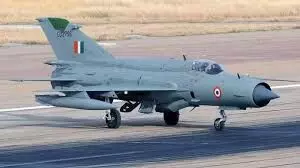Indian Air Force to Retire MiG-21 Fighter Jets by September: End of an Era for the 'Flying Coffin'
IAF to retire MiG-21 jets by Sept 19 after six decades of service marked by war victories and fatal crashes, ending a historic yet troubled legacy.
image for illustrative purpose

An iconic but contentious chapter in Indian military aviation will come to an end on September 19 when the Indian Air Force (IAF) formally retires its final MiG-21 fighter jets. At the Chandigarh airbase, a ceremonial decommissioning will conclude the last chapter of an aircraft that served as the backbone of the IAF's combat fleet but became known over time as the "flying coffin."
A Tragic Legacy of a War Veteran
Introduced in 1963, the Russian-origin MiG-21 was India's first supersonic jet and served with distinction in several wars, including the Kargil conflict in 1999, the Indo-Pak wars in 1965 and 1971, and more recently, the 2019 aerial skirmish, in which Group Captain Abhinandan Varthaman used a MiG-21 Bison to down a Pakistani F-16.
Notwithstanding its successes, the aircraft has a dismal accident record. Over 500 MiG-21s have crashed, killing more than 170 pilots over the course of 60 years, according to government data. Technical malfunctions, bird strikes, and human error are some of the causes.
The Reasons for Retiring the MiGs
Three MiG-21 Bison squadrons, each with 16–18 aircraft, are still in use today. Starting with the No. 51 Squadron, based in Srinagar, which retired in 2022, the IAF had been phasing them out gradually. The domestically produced Tejas Mark-1A fighter fighters are expected to replace the remaining aircraft.
The IAF's lack of squadrons—42 are sanctioned, but only roughly 30 are in operation—was a major factor in the postponed retirement. It would have further undermined air defence capabilities to phase out the MiG-21s before replacements were operational.
The History and Initial Role of MiG-21
India aimed to strengthen its air force after the 1962 war with China and growing hostilities with Pakistan. For the MiG-21s, India looked to the Soviet Union, while the US provided Pakistan with the F-104 Starfighter. When the first six planes arrived in April 1963, Soviet engineers put them together in Bombay before they were transported to Chandigarh.
In the end, India acquired more than 700 MiG-21s of different models, such as Type-77, Type-96, BIS, and the upgraded MiG-21 Bison with contemporary radars and avionics.
Political and Cultural Effects
The impact of the MiG-21 extends beyond the battlefield. A national issue, Flight Lieutenant Abhijeet Gadgil's fatal 2001 crash and his mother Kavita Gadgil's advocacy for pilot safety shaped the plot of the popular 2006 movie Rang De Basanti.
Notwithstanding its record of successes, the MiG-21's lengthy service came at a tremendous human cost, which eventually overshadowed its achievements.
The Last Salute
The MiG-21 will be remembered for its contribution to the IAF's air superiority as well as the numerous casualties it caused during its lengthy service, as India gets ready to say goodbye to it. The September 19 retirement ceremony will honour the jet's intricate and legendary history.

